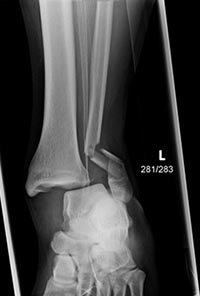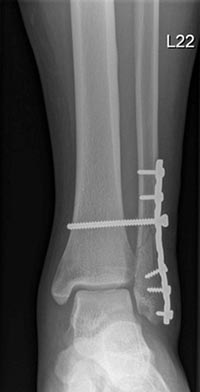 What is an ankle fracture?
What is an ankle fracture?
An ankle fracture is a break (or breaks) of the bones that make up the ankle i.e. the fibula and/or tibia.
Why do they occur?
Ankle fractures occur when a force of significant enough size passes through the ankle in such a direction that the bones cannot resist it and as a result the bones ’fail’ and break.
There are a variety of different types and severity of ankle fractures and therefore the treatment will vary.
These usually occur following one episode, however so called stress fractures may also occur after repeated smaller forces eventually overwhelm the capacity of the bone to cope with the ’stress’.
What symptoms do they cause?
Pain: Obviously the initial injury is painful, however this should settle within about 3 months of the injury. There are a number of reasons why the ankle may continue to be painful:
-The fracture/ break may not join up- this is uncommon, however the likelihood of this is increased if you smoke.
-The the injury that leads to the fracture can also cause damage to joint surface cartilage (see Ankle Cartilage Defects)
– Arthritis may develop in the ankle in the long term (see: Ankle Arthritis). This is more likely if the correct position of the ankle is not maintained while the break(s) heal up they may join up in the wrong place (malunion).
Stiffness: This can occur due to scarring occurring around the ankle.
Instability: The ankle might feel insecure after the break has healed, this is often due to lack of confidence, but also as the feedback from the receptors around the ankle has not returned to normal.
The stiffness and instability can often be helped by physiotherapy.
For these above reasons it is important that ankle fractures are assessed and treated properly.
 What options are there for treatment?
What options are there for treatment?
a. Plaster
In a number of cases if the breaks are in a good position, plaster may be all that is required, the pattern or type of the break will determine if the patient will be permitted to bear weight through the plaster. The type of fracture and the speed with which the bone heals will determine the length of time that the ankle needs to be in plaster.
b. Braces/ Pneumatic boots
Some fractures do not need to be in plaster and can be treated in an ankle brace or a pneumatic walking boot. Any decision to treat a fracture in this way requires appropriate assessment by a specialist.
c. Surgery
This is required the fracture is displaced and in certain other circumstances. Surgery does not necessarily need to occur on the day of the injury and indeed is often delayed until the swelling has settled at about 5 days following the injury. Plaster is usually required for 6 weeks after surgery.
For further information regarding having your ankle assessed and treated privately please contact Mr. Jowett’s secretary on the number below.
